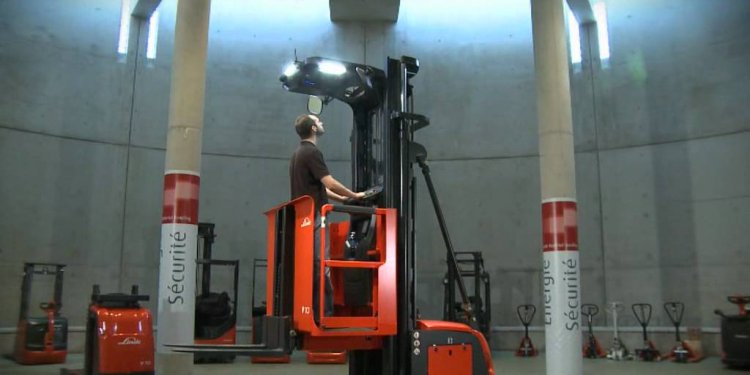
|
Figure 2. Reach truck with pantograph attachment that scissors forward from the mast to retrieve the pallet. |
Reach trucks are a type of Class II electric motor narrow aisle truck. These trucks are used for high tiering, which involves storing material in multiple tiers high off the ground.
Potential Hazards:
- Danger of overloading, especially on high lift.
- Danger of tipover.
Requirements and Recommended Practices:
- Check pallet weight before lifting.
- Place heaviest loads on the bottom racks, and lighter loads on the top.
- Do not exceed the load capacity of the lift truck with attachments such as a pantograph attachment. (Figure 2)
- Do not lift the heaviest load to the maximum lift or stacking height. There may be a loss of stability.
|
 |
|
Figure 3. Order picker operator using full body harness. |
Order picker trucks are another type of Class II electric motor narrow aisle truck. These trucks are designed to lift the operator to retrieve items.
Requirements and Recommended Practices:
- Wear appropriate fall protection equipment that is properly fitted and adjusted. Ensure that employees are trained in the proper use of the fall protection equipment.
Additional Information: |
 |
|
Potential Hazards: Requirements and Recommended Practices:
Figure 4. Stored material stacked safely. |
OSHA's Powered Industrial Truck Standard includes a series of rules for safe stacking:
- Only stable or safely arranged loads shall be handled. Caution shall be exercised when handling off-center loads which cannot be centered. [29 CFR 1910.178(o)(1)]
- Only loads within the rated capacity of the truck shall be handled. [29 CFR 1910.178(o)(2)]
- The long or high (including multiple-tiered) loads which may affect capacity shall be adjusted. [29 CFR 1910.178(o)(3)]
- Trucks equipped with attachments shall be operated as partially loaded trucks when not handling a load. [29 CFR 1910.178(o)(4)]
- A load engaging means shall be placed under the load as far as possible; the mast shall be carefully tilted backward to stabilize the load. [29 CFR 1910.178(o)(5)]
- Extreme care shall be used when tilting the load forward or backward, particularly when high tiering. Tilting forward with load engaging means elevated shall be prohibited except to pick up a load. An elevated load shall not be tilted forward except when the load is in a deposit position over a rack or stack. When stacking or tiering, only enough backward tilt to stabilize the load shall be used. [29 CFR 1910.178(o)(6)]
In addition, the following are recommended:
- Move forks as far apart as the load will permit. Be sure the load is centered and the forks are completely under the load before lifting.
|
Source: www.osha.gov







